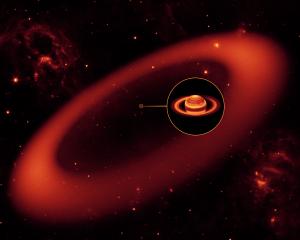Blog
Ring Around the Rosie
17 November 2013
The rings of Saturn are perhaps the the most famous ring system in our solar system. Pictures of the rings are all over the web, most recently the composite image from Cassini. But what we think of as Saturn’s rings is only part of the story, because what we’re familiar with are the rings as seen in visible light. There’s actually more to Saturn’s rings when viewed at other wavelengths.
 NASA/JPL-Caltech/Keck
NASA/JPL-Caltech/KeckFor example, when viewed in the infrared, we find that Saturn has an additional (and very large) ring. This ring was first reported in Nature,1which is unfortunately paywalled, and you can see a rendering of the ring here. This particular ring is very diffuse, so it doesn’t reflect much visible light. However the ice and dust emits a small amount of infrared radiation (heat) so it is visible at infrared wavelengths.
The familiar rings of Saturn extend out to about 150,000 kilometers, but this larger ring extends from 6 to 12 million kilometers. It is roughly centered around the orbit of the moon Phoebe, which is why it is known as the Phoebe ring. It’s generally thought that the material of the ring comes from micrometeor impacts with Phoebe. Since Phoebe is in a retrograde orbit it is much more likely to suffer impacts from the rest of the Saturnian system.
Near the inner range of the Phoebe ring is the moon Iapetus, which is famous for having an unusual surface. One side of Iapetus is rather bright, while the other side is quite dark. Since the 1970s it has been suspected that this might be related to material captured from Phoebe. We now know that as Iapetus orbits it intersects the inner part of the Phoebe ring. So it seems the darkened side of Iapetus is due to particle collisions with the Phoebe ring.
Verbiscer, Anne J., Michael F. Skrutskie, and Douglas P. Hamilton. “Saturn’s largest ring.” Nature 461.7267 (2009): 1098. ↩︎